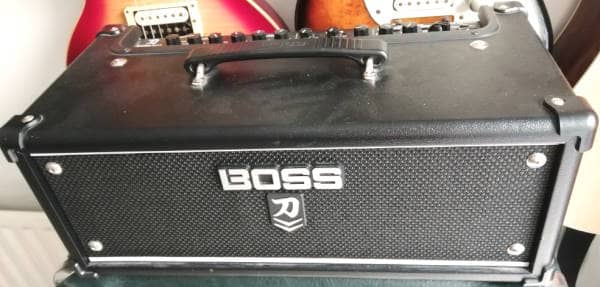
Despite all the guitar amplifier simulator software available to us these days, a real physical guitar amp is still an almost essential piece of gear for the electric guitar player. There is still nothing like turning it up, cranking the amp and really feeling it!
I recommend the Boss Katana (Amazon affiliate link) for a home studio. It sounds fantastic, has all the effects you could ever want built-in and doesn’t need to be turned up to high volumes to sound great. It can also be connected to your computer to create new sounds and download more effects and presets.
The link above is for the Boss Katana 50, which is a 50 watt combo. This is ideal for a home studio, and should you venture away from home it is easily loud enough for small gigs without being mic’d up. There are several other models in the range; check them out here – Boss Katana range (Amazon affiliate link).
I own the Boss Katana 100 Head (Amazon affiliate link), which you can see in the picture at the top of the page. It is the amp I play at home the most by far.
Great amps for recording
You can great sounds recorded from the Boss Katana, essentially in two different ways…
- Mic’ing up the amp’s speaker in the traditional way
- Use the line out jack to go straight into your audio interface, bypassing the speaker and allowing silent recording
You can get excellent sounds from the Katana even at low volumes through the speaker. But if you want true silent recording – perhaps you live in an apartment and have neighbors very sensitive to noise – taking a jack cable from the record out socket into an input on your audio interface allows you to do that. This gives you access to all the features of the amp (effects, presets, etc) without any of the external noise.
And mentioning those effects…it’s incredible what’s built into the Katana. I guess you’d expect that from a company like Boss, who have built their name on making fantastic guitar effects pedals for decades. Essentially, all the circuits from all Boss’s pedals are available in the Katana, either built-in out-of-the-box or downloadable using the Tone Studio software.
It would cost thousands upon thousands to buy all those effects pedals individually. Which makes the Katana a fantastic studio tool for experimenting with sounds and giving you a huge toolbox to get just about any guitar sound you could possibly imagine.
Solid state vs Tube
So why am I recommending a solid-state amp like the Katana rather than a tube amp? Guitar players get a little sensitive and protective around the subject tube amps, so I’ll tread a little carefully here!
I own several tube amps, and they are great. I have gigged with them on many occasions, and been extremely happy with the results. However, to get them to sound at their best, they do need to be cranked a bit, certainly to a volume that I would not be happy with turning up to at home. My family would certainly have something to say!
So I actually recommend solid state amps for home use. Regardless of what some gear snobs may say, you can get great sounds out of some solid-state amplifiers. It’s more to do with the individual guitar player, knowing the gear and learning how to record it than any particular technology. It’s still possible to record a bad sound from a tube amp!
Real amp or amp sim?
I must admit, these days I do most of my recording using amp sims (guitar amplifier simulator software). My favorite is BIAS FX, although I have used others such as Amplitube and Guitar Rig.
Having said that, I still own several real guitar amps, and I would advise any home studio to have one. You may stumble across a sound on your real amp that you just can’t get close enough to with an amp sim. And real amps are just more fun to play when practicing or learning a song. Plus the feeling of turning up and rocking out if you are lucky enough to live somewhere where you can is tough to beat. If you can capture that feeling in a recording session, there’s nothing quite like it.
If you also play guitar in a band, then I would always advise taking a real guitar amp. I know some guitar players these days do use a laptop and amp sim software on stage; I’m not quite ready for that! I’m very happy doing that in the studio, but for live use the computer & software is just another thing to go wrong. I’d rather not have my “amp” crash on stage mid guitar solo!


